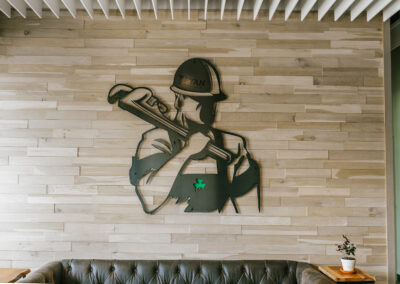The National Fire Protection Association’s standards (e.g., NFPA 25) list specific requirements for what equipment needs to be inspected or tested and how often. Some items need to be inspected or tested weekly, others monthly, quarterly, semiannually, annually, or after five years. Many of Ryan Fireprotection’s clients choose to have us come out quarterly and annually, while handling the more frequent requirements in-house. The following is a list of what should be checked during the quarterly and annual inspections for a typical wet- or dry-pipe fire sprinkler system.
Quarterly Inspection
The quarterly inspection includes everything that is required for a monthly inspection (1–2), plus some additional items (3–7):
- Inspect valves to verify that they are in the following condition:
- In their normal open or closed position
- Properly sealed, locked, or supervised
- Accessible
- Free from external leaks
- Free of physical damage
- Appropriately labeled
- (Alarm Valves) Retarding chamber or alarm drains are not leaking
- Inspect all of the gauges to verify they are in the following condition:
- For Wet Systems, gauges shall be inspected monthly to ensure they are in good condition and that normal water supply pressure is being maintained.
- For Dry Systems:
- The gauge on the supply side of the dry pipe valve must indicate that the normal supply water pressure is being maintained.
- The gauge on the quick-opening device, if provided, must indicate the same pressure as the gauge on the system side of the dry pipe valve.
- Gauges on systems with low air or nitrogen pressure alarms must be inspected monthly.
- Inspect water flow alarm and supervisory alarm devices for physical damage.
- Inspect and test the water flow alarm by opening the test connection on a wet pipe system and the bypass connection on a dry pipe system.
- If the sprinkler system is hydraulic, inspect the hydraulic nameplate to ensure that it’s attached and easily seen.
- Inspect fire department connections to make sure they are visible and undamaged, and ensure that gaskets and valves are not leaking or damaged.
- Inspect pressure-reducing valves and relief valves, if provided, to verify that they are:
- In the open position
- Not leaking
- Maintaining downstream pressures in accordance with the design criteria
- In good condition, with hand-wheels installed and unbroken.
Annual Inspection
The annual inspection includes everything in the quarterly inspection as well as the following:
- Inspect all sprinkler heads, including the pipes and fittings (floor level only).
- Ensure that there are extra sprinkler heads on site, as well as tools to change out the sprinkler heads.
- Inspect interior of dry pipe valves while resetting (if applicable).
- Conduct a main drain water flow test to determine whether there has been a change in the condition of the water supply piping. (This test is required quarterly if the water is supplied through a backflow preventer and/or pressure-reducing valve.)
Contact Ryan Fireprotection to schedule the quarterly and annual inspections of your wet or dry sprinkler system. Other systems such as anti-freeze, standpipe, hose, water spray, and foam systems have their own set of requirements. But whatever the system, Ryan Fireprotection can handle your required inspections and testing needs, as well as full sprinkler system installation. Ryan Fireprotection professionals can also resolve any issues found during the inspections to help keep your system functioning when it is needed most—when lives are on the line during a fire.
